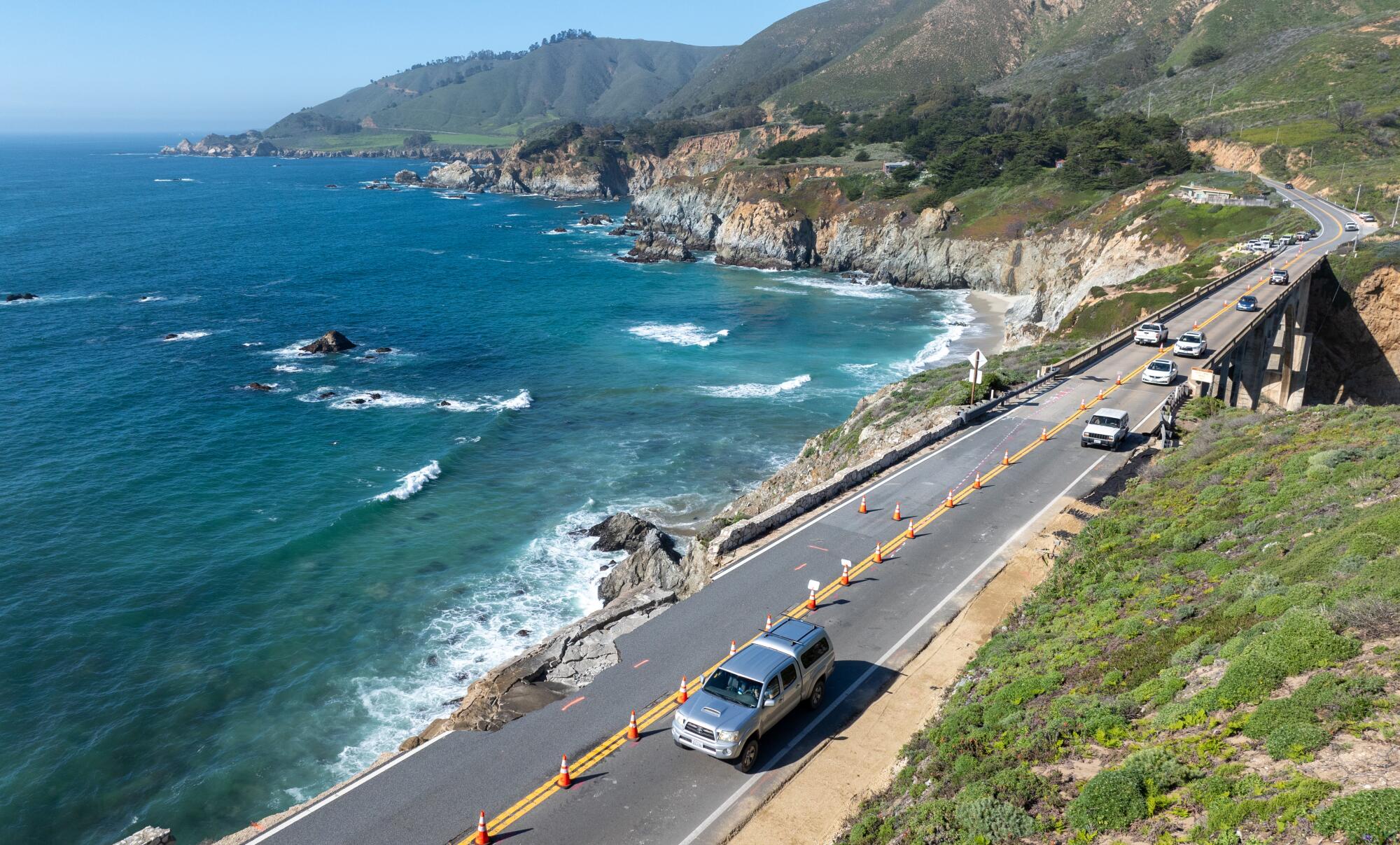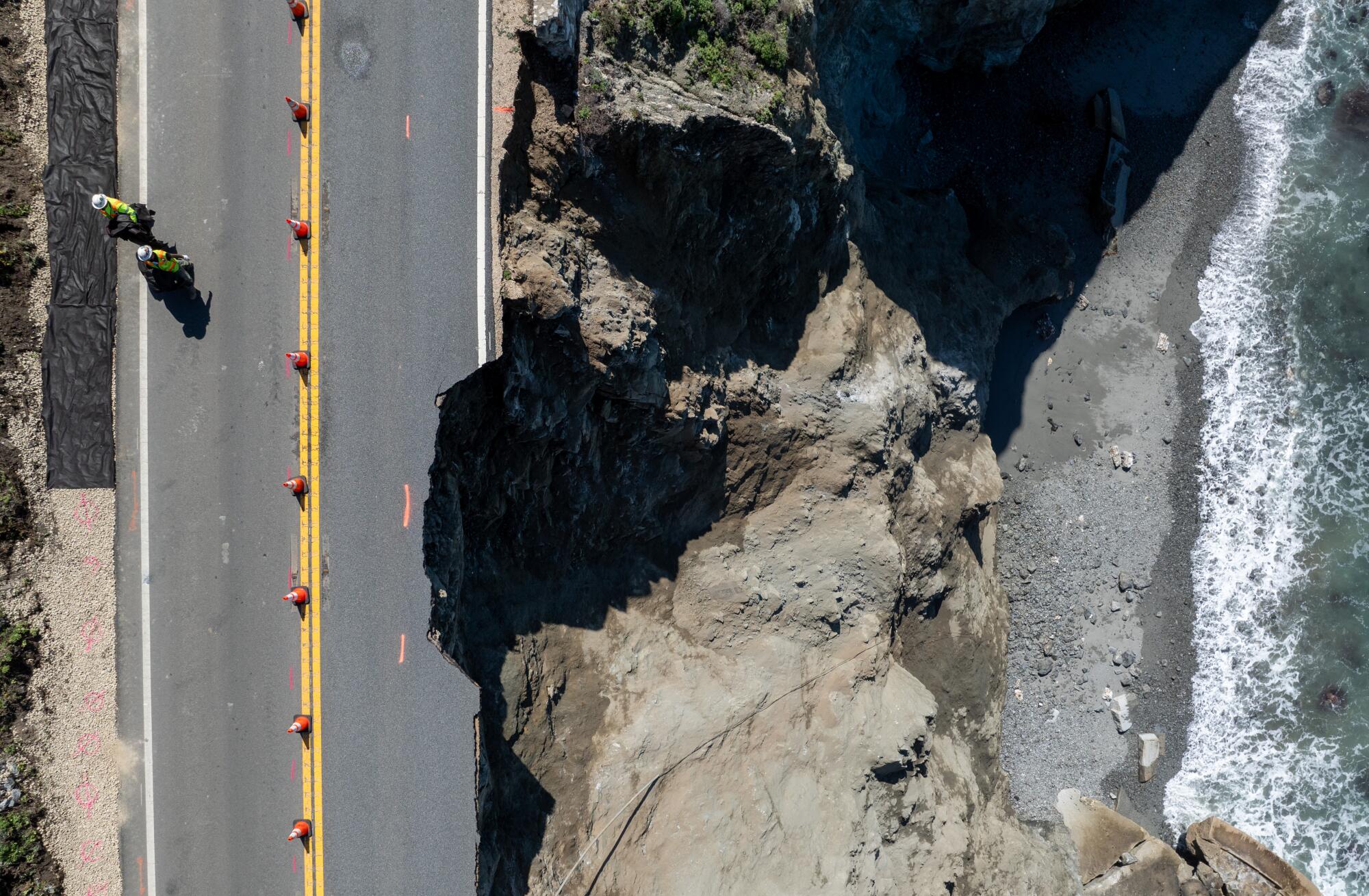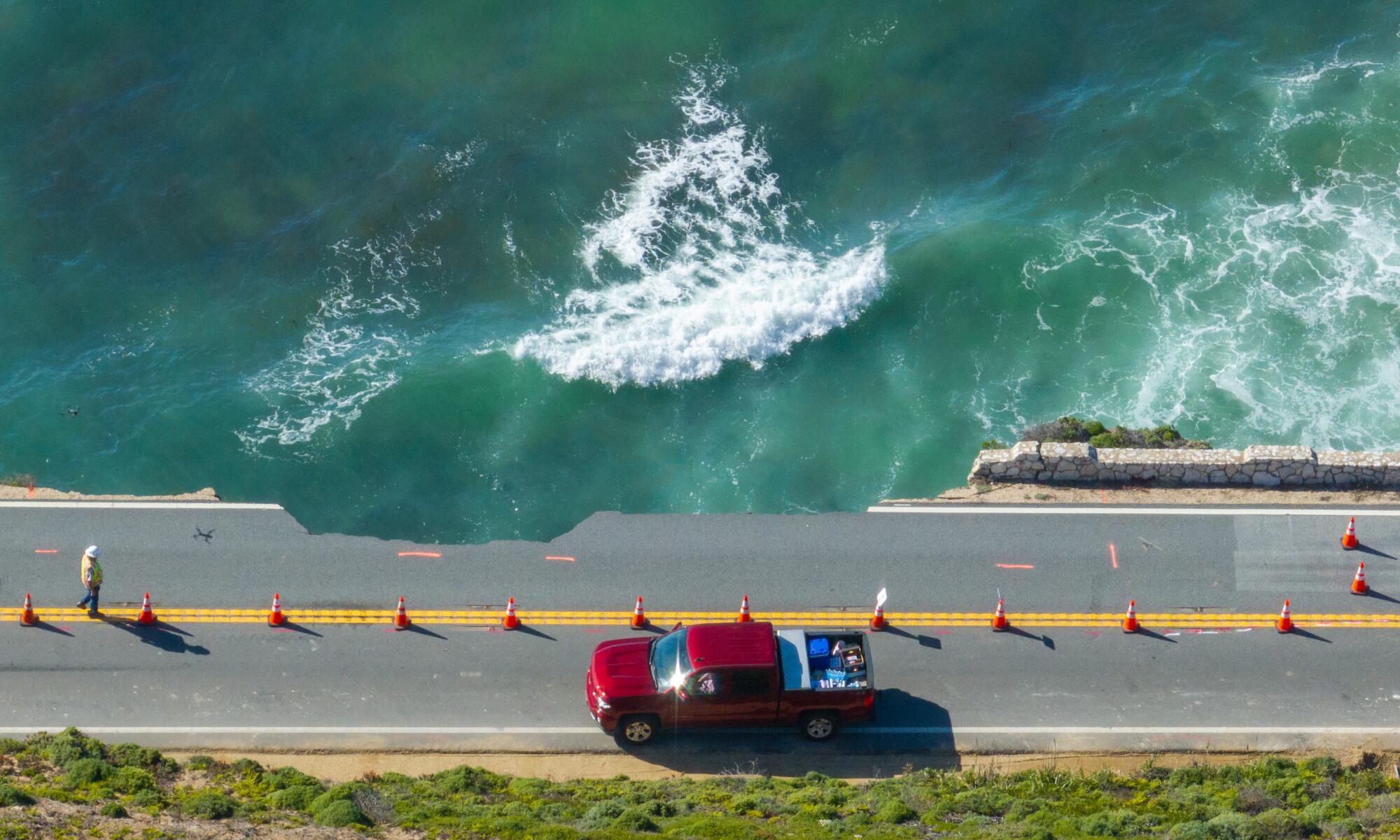With rain coming, convoys to halt across Big Sur slip-out

Communities and businesses caught between two major landslides on Highway 1 in Big Sur will once again be cut off from the rest of the state later this week when officials plan to temporarily stop convoys entering and leaving the region in light of rainy forecasts.
After a huge portion of the road fell into the ocean over the weekend in Carmel-by-the-Sea, officials closed a stretch of the scenic byway starting just above the Rocky Creek Bridge, about 40 miles north of an ongoing closure that begins near Limekiln. State park.
The new closure blocked exterior highway access from Palo Colorado Road to Limekiln State Park, but authorities allowed some travel through twice-daily regulated convoys on the northbound lane, which did not suffer obvious landslide damage. Access is limited to local residents and essential workers.
Highway 1 is closed as Caltrans crews assess the damage April 2, 2024 in Big Sur after the road slid south of the Rocky Creek Bridge.
Southbound and northbound vehicles queue at road closures before 8 a.m. and 4 p.m. Authorities then escort the vehicles in one direction then the other.
Authorities now say convoys will not travel on Thursday and Friday, as another Pacific storm is expected to bring more rain to the region. The National Weather Service is forecasting rainfall totals of between a half inch and an inch over Big Sur.
Stopping the convoys will mar residents and continue to cut off tourism businesses during one of Big Sur’s peak seasons.
“We want to be able, in the rain, to keep a constant observation of the slide and not put cars in it,” said Kevin Drabinski, a spokesman for the California Department of Transportation.
Rain continued to be responsible for land movements and road hazards in Big Sur, frequently keeping the famous highway closed for months.
On Monday, Drabinski said, about 275 cars each used the 8-hour and 16-hour convoys to access the nearly 25-mile stretch of Highway 1 that is now booked by the two landslide-related closures. An estimated 1,400 residents live between the two closures, said Nicholas Pasculli, a Monterey County spokesman.
Saturday’s Rocky Creek leak, as it is called, was “a surprise to everyone,” said Patte Kronlund, resident and executive director of the Community Assn. from Big Sur.

Vehicles are escorted through a closed section of Highway 1 in Big Sur.
“It’s literally 200 feet south of a landslide in 2011 that created the same situation, with one lane and two traffic lights on each end,” said Kronlund, who doesn’t hesitate to commend the Ministry of Transport for assessing the situation. too bad Sunday.
“They were confident that the northbound road could handle the weight of traffic,” she said, citing at least 2,000 vehicles – “trailers, campers, horse trailers” – that used the route. highway to head north from Big Sur on Sunday. or to return.
Drabinski said Caltrans’ goal is to eventually use that northbound lane to provide one-lane traffic 24 hours a day, but there is no official timetable for that. Right now, he said, crews are focused on laying 500 feet of concrete barriers along the centerline of the roadway to define a channel for vehicle passage and ensure worker safety.
Then the real work will begin.
“The first priority will be to stabilize the edge of the road,” Dabrinski said. “How do we first address that initial slippage and bring it to a state where it reaches an equilibrium?
He said engineers and construction crews are working on these difficult issues, but he said a permanent solution can only be found once the area stabilizes — something additional rain is known to disrupt.

Thomas Young, a professional civil engineer based in Roseville, Calif., with extensive experience in highway construction, said officials working on this project will focus on three elements: safety, maintenance and road capacity. .
Young, who spoke generally about such construction projects, having no direct knowledge of this latest landslide in Big Sur, said engineers and construction officials would first try to understand why the slope ruptured – which he said was probably linked to water infiltration. Next, the team will look for other cracks or slides around the rupture to determine the size of the affected area.
“Once you slide, you never get the same strength off the hill again,” Young said. He said there are a variety of solutions to repair such a slide, including retaining walls and tie supports that keep weakened sections of the hillside on a more secure foundation, but that almost all options come at a high price. He expects the plan will also need to consider drainage and water attenuation.
“At some point it becomes an economic burden,” he said. “It’s a fight against nature…. At some point, does it become untenable? Yeah. And is that in 10 years or 1,000 years?
But residents and businesses south of the recently damaged road are dedicated to the area, and the area continues to boost tourism.
Normally, more than 1,000 visitors a day take in the views and enjoy a meal at the popular roadside destination of Nepenthe, according to its general manager, Kirk Gafill.
“There are positive sides” to the current situation, he said by telephone, citing the rare calm that has fallen on this busy coastline. “But it’s not sustainable. It’s not realistic for people to live in this community without the highway being open. »
Gafill, who has lived in Big Sur his entire life, has experienced this before, including in 2017, when an atmospheric river undermined the Pfeiffer Canyon Bridge and closed the highway leading to the Big Sur community for seven months.
“The state estimates that this shutdown had a $500 million impact on the economy,” he said. “That was over a million dollars a day, not just for Big Sur, but for the entire state. Seven years later – with inflation-adjusted dollars – that closure will amount to even more per day.
Big Sur businesses know what to do during these downtimes, he said: Make repairs, clean facilities and hope the shutdown doesn’t last long.
“But we just don’t know,” he added.
The Rocky Creek slide is an insult to the real injury, Gafill said: the massive slide — known as Paul’s Slide — that buried the highway to the south in January 2023. It’s been blocked ever since; work on Paul’s Slide was to be completed by late spring, time permits.

Vehicles are escorted on Highway 1.
In addition, two new slides were developed in February in the same vicinity. The largest, with more than 300,000 cubic meters of earth, has not yet been cleared, leaving engineers uncertain about the condition of the road. Once work begins on this large slide – depending on dry weather – Caltrans estimates it will take three to four months to complete the repair.
“The Big Sur coastline – the community, its businesses, its residents and its employees – has been impacted economically since 2016 after a series of back-to-back disasters,” said Kronlund, who sees it all starting with the Soberanes Fire, which burned for four months in Garrapata State Park, destroying 68 structures and killing a bulldozer operator.
Over the years, the Big Sur coast and adjacent Santa Lucia Range have proven particularly vulnerable to atmospheric rivers and fires, including the 2020 Dolan Fire.
As a result of Paul’s Slide, Kronlund estimates that businesses north of the road closure, which includes most of Big Sur, saw revenue decline by 35 percent, while those south of the slide experienced a drop of almost 50% or more. .
To help families and businesses affected by this closure, the Community Assn. of Big Sur launched a fundraising campaign through its website, citing the economic damage caused by road closures to the north and south.
California Daily Newspapers


